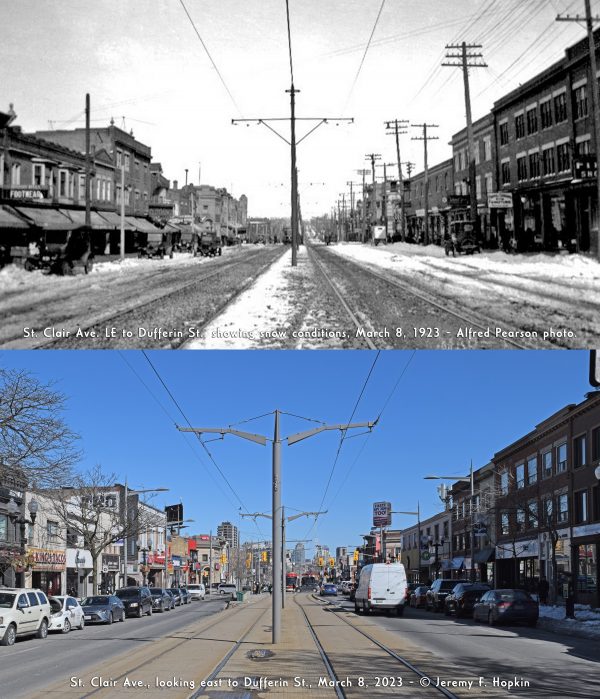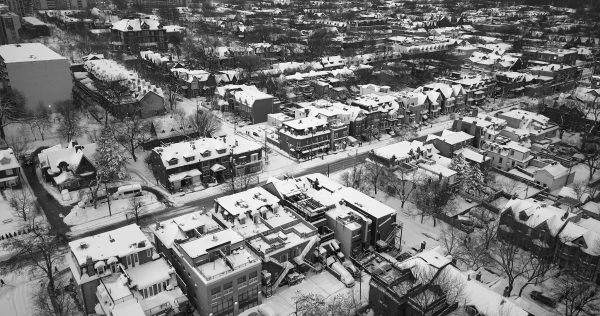
One day last week, Toronto history buff Jeremy Hopkin tweeted a then-and-now set of images that told an unflattering story about where we find ourselves. He paired a 1923 photo of St. Clair West, looking east to Dufferin, with one he took a century later, on March 8, 2023.
Apart from the colours and the vehicles, a staggering detail jumps out: the streetscape has barely changed, with the exception of some merchant awnings. Here we are, on a six-lane arterial kitted out with a dedicated streetcar right-of-way, and there’s been virtually no intensification on this corridor in a hundred years. Talk about incrementalism.

By happenstance, I’d participated that week on a Toronto Metropolitan University panel about city-building with architect Naama Blonder, a co-founder of Smart Density. Originally from Israel, she spoke of coming to Toronto almost a decade ago and deciding one day to explore by taking transit out of the core. Blonder ended up on St. Clair West, which didn’t seem all that far, but felt, she said, like a much more remote suburb — the mostly two-storey street wall bearing little resemblance to the comparably far denser streets of Tel Aviv, which are lined with mid-rise apartments.
The question posed by St. Clair West, and indeed hundreds of kilometres of other major streets across the city, is this: why are they so hostile to almost any kind of sustained intensification? Where are the rows of mid-rise buildings, as envisioned by city council way back in the early 2000s when the first post-amalgamation Official Plan was approved?
As per a council directive from before Christmas, it appears the city’s planning department is going to take another crack at this vision — one that will, in theory, include Toronto’s so-called major streets — a network of collectors and minor arterials that cover over 1,200 km of the city. Think about Mount Pleasant north of Davisville, much of Lawrence Ave through the core, most of Dufferin south of Lawrence, O’Connor, St. Clair East in Scarborough, or, indeed, more inarguably urban addresses, like Beverley Street south of College — a stretch that should, by all rights, be lined with mid-rise apartments a la St. George Street.
This move is part of the city’s much more comprehensive effort — dubbed the “Housing Action Plan 2022-2026” — to accelerate the production of new housing, and specifically multiplexes, mid-rises, and affordable rentals as a means of addressing both the crisis in the cost of housing and rent as well as the Ford government’s targets for new supply.
According to a staff report released this week that’s heading for executive committee, the planning department’s “work plan” includes exploring the prospect of allowing four-to-six storey walk-ups in residential zones along major streets (under 30 metres wide) and simplifying approvals to incent more mid-rise along arterials and avenues. Proposed official plan and zoning bylaw amendments, say the report’s co-authors, chief planner Gregg Lintern and housing czar Abigale Bond, will be cooked and ready to serve to council by the end of the year.
I don’t want to be excessively cynical, but we’ve seen this movie before.
A generation ago, Torontonians were told that the city’s future lay in the development of avenues lined with mid-rise mixed-use buildings that would provide sufficient density to justify higher order transit.
Didn’t happen.
Instead, we wasted two decades nibbling away at this vision with “avenues studies,” “mid-rise guidelines,” “performance standards,” elaborate set-back requirements, and all manner of bureaucratic busy-work — everything, indeed, except the one move that would have enabled the plan to be realized: blanket “as-of-right” zoning to align the city’s land use regulations with its land use policies.
There’s a demure allusion to this epic own-goal in the staff report: “Current Neighbourhood policies in the Official Plan permit additional intensification along Major Streets under specific circumstances,” it notes. “However, permissions for low-rise apartments along Major Streets is not consistently permitted through the applicable zoning by-law.” As for the Avenues (e.g. places like St. Clair West), the planners say they’ll “explore policy, zoning and guideline changes to simplify approvals and facilitate the development of mid-rise buildings along Avenues and in Mixed Use Areas.”
These explorations include considering the use of “transition zones” for smaller scale apartments that would sit between the higher densities envisioned for avenues and the low densities in the surrounding neighbourhoods. But the report is already chock-a-block with hedgy language, as such a move will raise the hackles of ratepayer groups and their council allies.
In fact, almost all of this stuff has already been studied to death. In 2015, for example, council quietly shot down a tentative staff proposal to test transition zones. The problem isn’t a lack of analysis. Rather, it’s about how to rip the band-aid off quickly and provide as-of-right zoning along main streets, especially those served by transit — i.e., the crazy idea that you could acquire some property and add a moderate amount of density without being forced to endure the costly contortionist act of figuring out how to please all of the parties that need to be pleased in order to get to yes.
A generation ago, many Torontonians, and, frankly, we in the media, thought that the vision of mid-rise intensification along the avenues would come to pass because it was enshrined in the city’s ur-plan.
The building industry, however, encountered another story all together: each parcel required OPAs or re-zonings, which meant fighting with the neighbours and the planning department and local BIAs and impatient investors. All the while, downtown sites were scoring multiple times the density, and many builders who’d tried their hands at mid-rises decided these projects were one-and-done affairs — way too much trouble for too little reward.
The City, in effect, defeated itself: the bold rhetoric of `as-of-right’ approvals — a hold-over from the mid-1990s, when the old City of Toronto enacted “the Kings” plan to revive the warehouse districts — faded almost as soon as the ink on the Official Plan had dried. In the subsequent battle between big visions and planning minutiae, the nitpickers won hand’s down.
Have we learned anything?
Not sure.
The planning department, for instance, could say it will provide more permissive or even as of right zoning for multiplexes in established neighbourhoods or along major streets, but council could easily kill the baby in its crib by imposing development charges or on-site parking requirements that make such projects economically preposterous.
To my eye, this week’s staff report, for all its bold talk, doesn’t feel especially bold. The word “study” appears no fewer than 21 times in the 31-page document; the word “deliverable,” just twice. We spent a fifth of a century studying the problem of why St. Clair West hasn’t changed in a hundred years. The answer, at this point, is surely staring us in the face.
top photo by Sam Javanrouh; collage photo by Jeremy Hopkin





6 comments
Lots of new Condos going up on St. Clair now.
People on those streets and avenues see local shops and businesses being killed by any degree of intensification, because they see what is happening e.g. in Midtown at Yonge and Eglinton. I can see that St Clair West needs to be revived but they do not want to see it turned into what is ongoing at Y&E.
All major streets (those with streetcar/subway routes) should be designated for three storeys (assuming that is correct maximum allowed without elevator as per fire code). with no requirement for vehicle parking but with bicycle lockers. Possibly allow with minimal approval requirements for small high rise (4 to ?) storeys only at subway stations within XXX feet of all four corners. Make the most of what we already have without major disruption of exisitng neighbourhoods.
The St. Clair right-of-way in 1923 did not have left turn lanes for the auto. The autos had to yield to the streetcars before turning left.
The 2023 got left turn lanes, taken space away from the sidewalks. Also, left turning single-occupant autos get priority ahead of the 100+ people onboard the streetcars.
First of all, I’m not sure that “intensification” will actually improve streets like St Clair that already have small commercial and residential over top. Instead of local retail and older rent-controlled apartments, what is the advantage of replacing them with condos with yet more ground-floor chain coffee shops/drug stores/pet store?
Intensification is happening on streets that are further out, that don’t much have the relatively dense front of St. Clair, Bloor/Danforth, Yonge, etc. Go along The Queensway, Lawrence Ave out in Don Mills and Scarborough, and many other suburban arterials where car dealerships and old commercial properties or left-over bungalows are being densified. Yep, more condos with ground floor drug stores/coffee shops/pet stores, but probably more useful than Joe Schmoe’s Guaranteed Used Cars.
And in fact there has been densification and midrises on St. Clair, just not on this particular stretch.
I think Lorinc can do better….
But alas, there is a major difference between “then” and “now”: The trams were faster back then.